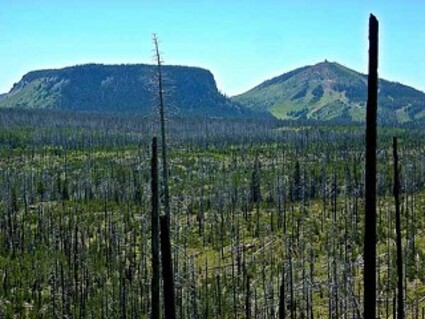Tuya: A distinctive local geological feature
Last updated 8/23/2016 at Noon

Craig Eisenbeis
Hayrick Butte, on the left, with its rocky hoodoos, is a classic example of a volcanic tuya.
Tuyas are relatively rare and unusual geological features that are found in exotic cold-climate locations such as far northern British Columbia, Iceland, Antarctica, and Tuva, Russia, near the Siberia-Mongolian border.
If you don't want to go that far to see one, there is one other place on the planet where they can be found that is not quite so hard to reach. You can simply drive up to Santiam Pass.
Hayrick Butte and Hogg Rock are two classic examples of an unusual flat-topped geological phenomenon with vertical sides called tuyas. Hogg Rock is the massive block of stone on the north side of Highway 20 that the road clings to and wraps around, just west of the Santiam Pass summit. Hayrick Butte is the flat-topped, rocky companion of Hoodoo Butte, home of Hoodoo Ski Resort.
Tuyas are formed when a volcano erupts from beneath a thick sheet of glacial ice and burns its way to the surface. As the molten rock melts its way into the bottom of the glacier, the lava directly in contact with the ice begins to cool rapidly, forming a vertical wall of rock that forms a dike of sorts encircling the eruption. Like a child's backyard inflatable wading pool, this solidifying ring of rock cradles a pool of the still-liquid lava and insulates it from the glacier as the flow continues.
When the contained lava pool itself finally solidifies, what is left - after the glacier is gone - is a huge, circular, flat-topped block of rock. The presence of tuyas at Santiam Pass is, therefore, further evidence of extensive past glaciation of the area.
The word "tuya" comes from the name of the prototypical Tuya Butte in northern British Columbia. The term itself was applied worldwide to all formations of this nature, after the geological phenomenon was first studied in Canada's Tuya Range. Now preserved in British Columbia's Tuya Mountains Provincial Park, the area is located about 150 miles east-northeast of Juneau, Alaska, and 60 miles south of the Yukon border. The word "tuya" is believed to be derived from a local native, or First Nation, language of Athabaskan origins.
Our local tuya of Hogg Rock is named for "Colonel" Thomas Egenton Hogg, an Oregon railroad promoter of the late nineteenth century. He wasn't really a colonel, and the Hogg Rock project wasn't much of a railroad. Hogg Rock was the site of Hogg's ridiculous farce of a railroad fiasco that involved a mule-drawn rail car over a short stretch of track.
Hogg's deception was designed to allow him to technically claim that he had completed a trans-Cascade Range railroad crossing. Hogg's railroad crew laid a short stretch of track over the pass. Then, in wagons, he hauled a disassembled boxcar to the site and had it put back together. To complete the ruse, he boldly proclaimed that the mule-drawn rail car, which was dragged across the summit, constituted a real railroad entitling him to the fruits of his "completed" contract - but that's a story for another time.
On the south side of Highway 20, the tuya known as Hayrick Butte also has a very interesting tale of how its name came to be. Local lore has it that the names of Hoodoo and Hayrick Buttes were inadvertently switched by a cartographer unfamiliar with the Santiam Pass landmarks, and that story makes a lot of sense.
The term hoodoo is associated with rock promontories and buttresses such as those found along the outer margins of present-day Hayrick Butte. "Hayrick" is merely another word for haystack; and - not so coincidentally - the shape of the present-day cinder cone of Hoodoo Butte very much resembles a haystack. It is easy to draw a conclusion as to which name belongs where, and the story of the confused mapmaker seems altogether plausible. Regardless, the names were recorded and have persisted to this day.
So, now that you know all about this unique geological form, you will have a snappy comeback when someone addresses you with the challenge of "What's it tuya?"
















Reader Comments(0)